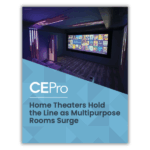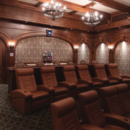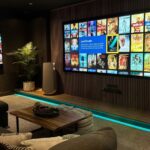At 92 million individuals, Millennials represent 40 percent of the U.S. population. They represent $600 billion in buying power in 2015 and that figure is expected to rise to $1.4 trillion by 2020. They are already the largest demographic and the good news for custom integrators is that these web-savvy individuals are just nearing their prime buying age for high-end electronics.
But not so fast. Millennials – those born between 1980 and 2000—can be a tricky group to get to mainly because Google is constantly changing the game daily for web marketing.
“You must be found online even if you don’t sell online,” is his simple advice for integrators.
He notes that despite all the hype about the web taking over the custom installation industry, only 7 percent of all product sales are made via the web. Of course, almost all of those products are searched for on the web, but it is still a relatively small percentage of products that is being actually purchased.
The data for Millennials and home technology is strong. According to a study from PR Newswire, 70 percent of Millennials want home tech to help them manage their daily lives better. Also, 64 percent of them said home technology is more important than curb appeal when buying a new home, according to a survey by BHG.
To stay ahead of the curve, Tim McLain, enterprise marketing manager for Netsertive, offered these six sage web marketing advice to target Millennials during the opening session at the CE Pro Summit in Washington, D.C.
1. Focus on mobile – Millennials are bound to their smartphones. Four out of every five own one. Among this group, web traffic from mobile devices is higher than what is produced from desktops. McLain cited research that the average person looks at their smartphone between 80 and 200 times per day.
2. Claim your “Google My Business” account – Google allows businesses to register themselves, in essence, via its “Google My Business” tool.
“This forms the foundation of your Google success,” says McLain bluntly.
When an integrator claims his account by filling in the name of his company, what products and services he or she sells, the exact address, etc. Once registered, the tool does things like accurately locate the little “pin” on a map of your location.
“Haven’t you ever noticed that in many cases those pins are not exactly in the right location?” asks McLain rhetorically. “That is because the business owner has not set himself up in Google My Business.”

Google My Business
3. Activate “Click to Call” in your digital ads – This is exactly what it sounds like, but as an advertiser you need to activate that feature in Google. McLain says there has been a 600 percent increase in calls from consumers using the Click to Call feature in recent years. By the way, Netsertive tracks the Click to Calls for its clients and records those calls.
4. Activate “Location Extensions” in your digital ads – Again, this is logical. This activates the feature that can automatically generate a map with directions to your business.
5. Make Viral Videos! – This is McLain’s biggest advice of all. Netsertive research shows that nearly half of all 18- to 34-year-olds are twice as likely to use YouTube to learn about their passions. As a group, they are watching videos online twice as often as the average web user. Plus, two in three list their greatest trust in user-generated content.
“Google is the No. 1 search engine in the world. No. 2 is YouTube,” says McLain.
He cites the Ford “Fiesta Movement” viral video campaign in which the automaker sought out successful YouTube videomakers and gave them “challenges” to complete with a Ford Fiesta car. Things like “drive as far as you can on one tank of gas and make a video out of the experience.”
The results were stunning: Ford spent only 4 percent of what it would have spent on traditional advertising. The campaign generated 200 million YouTube views, 50,000 requests for more information on the Ford Fiesta, and 10,000 Fiestas were sold in the first six days.
6. Watch Your Language – Millennials respond to different words than Baby Boomers. While older generations put credence in things like “duty,” younger Americans are into “discovery, sharing, passion, experience and diversity.” McLain advises: “Use these words in your marketing.”













